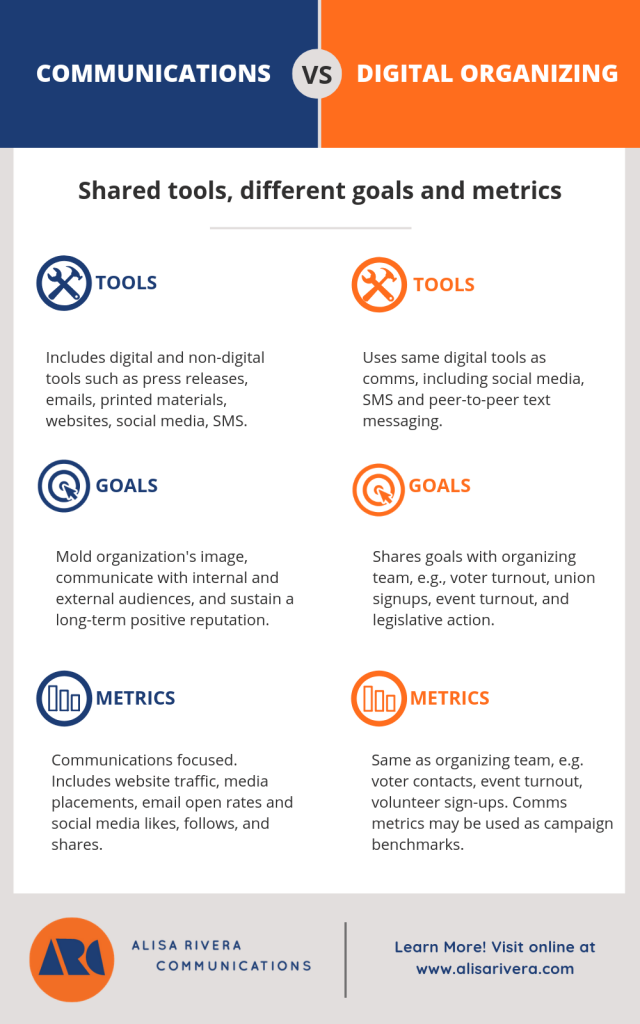Communications vs. Digital Organizing
What’s the difference and why it matters.
Part One of a Two-Part Series
Digital organizing is one of the most effective ways for progressive organizations to mobilize supporters and drive voter turnout. Social media, peer-to-peer text messaging, mass SMS, and even search engine marketing are all playing an enormous role in political campaigns and issues-based movements such as labor, reproductive rights, and immigrant rights.
In most organizations, digital communications tools are under the control of the communications/marketing department. But communications departments aren’t well positioned to support organizing because of fundamental differences between the goals of the function and the needs of field campaigns.
Shared tools — but different goals and measures
Communications departments work on developing, cultivating, and maintaining an organizational identity or brand image. Tools and functions housed within communications include media and public relations, marketing emails, printed materials, website design and maintenance (including content production), SMS, and social media. They are also responsible for internal communications with organization staff.
By contrast, digital organizing is focused on meeting the goals of organizing campaigns. While digital organizing teams use many of the same tools as the communications team (social media and SMS in particular), they use the tools to do things like drive voter turnout, union signups, event turnout, and legislative action.
Digital organizing measures success using the same metrics as the field organizing team.
Communications departments measure success using their own metrics, including website traffic, email open and click-through rates, media placements and quality of coverage, and social media likes, follows, and shares.
Digital organizing measures success using the same metrics as the field organizing team: How many people turned out for your event? How many supporters called and texted elected officials about your issue? How many people turned out to vote? While communications-related metrics have value as milestone measures and help refine messaging and target audiences, they are not the ultimate drivers of the digital organizing strategy.
To be somewhat reductive, communications metrics generally exist in the digital and media space while digital organizing metrics focus on actions taken by target audiences outside of digital spaces.
Communications isn’t well-positioned to take on digital organizing
Because communications exists as a separate entity with its own goals and metrics, most communications teams are not well-positioned to effectively support field organizing. Issues that commonly arise when communications is tasked with digital organizing are:
● Communications team does not have the capacity to rapidly respond to the needs of a fast-moving field campaign.
● Communications team is not included in strategy or daily planning meetings with the field team and as a result does not have a clear understanding of field goals and organizing needs.
● Field organizing director and team do not understand how digital communications tools can support and drive field goals and do not include those tools when planning field strategy.
● Staff tasked with digital organizing report to the director of communications, which can create conflict between the needs of the communications team and field organizing team.
So what does this mean for your organization? What do you need to put into place to ensure the success of both the communications team and field organizing team? In Part 2 of this series, I discuss how you can best position your organization and avoid a conflict that can sink your ability to meet your goals.
Below is an infographic you can use with your staff to differentiate between the functions of communications and the digital organizing team. A PDF version can be downloaded here.


